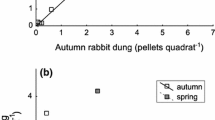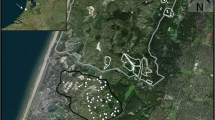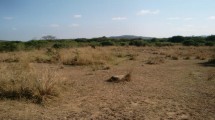Abstract
We examined the effect of native large herbivores on aboveground primary production of nonforested habitat in Yellowstone National Park, Wyoming. Productivity of vegetation grazed by elk (Cervus elaphus) and bison (Bison bison) was compared with that of ungrazed (permanently fenced) vegetation at four sites. Two methods were used that, we believed, would provide the most accurate measurements under the different grazing regimes encountered in the study. Production of ungrazed vegetation in permanent exclosures (10×10 m or 15×15 m, 3 per site) and that of vegetation that was grazed only in the winter was taken as peak standing crop. Production of vegetation grazed during the growing season was the sum of significant increments (P<0.05) in standing crop inside temporary exclosures (1.5×1.5 m, 6 per site) moved every four weeks to account for herbivory.
Aboveground productivity of grazed vegetation was .47% higher than that of ungrazed vegetation across sites (P<0.0003). This result could be explained by either a methodological or grazer effect. We believe it was the latter. Results from a computer simulation showed that sequential sampling with temporary exclosures resulted in a slight underestimation of production, suggesting that the reported differences between treatments were conservative. We suggest that stimulation of aboveground production by ungulates may be, in part, due to the migratory behavior of native ungulates that track young, high quality forage as it shifts spatially across the Yellowstone ecosystem.
Similar content being viewed by others
References
Biondini ME, Lauenroth WK, Sala OE (1991) Correcting estimates of net primary production: Are we overestimating plant production in rangelands?. J Range Manag 44: 194–198
Burke IC (1989) Control of nitrogen mineralization in a sagebrush steppe landscape. Ecology 70: 1115–1126
Burke IC, Reiners WA, Schimel DS (1989) Organic matter turnover in a sagebrush steppe landscape. Biogeochemistry 7: 11–31
Coughenhour MB (1991) Biomass and nitrogen responses to grazing of upland steppe in Yellowstone's Northern Winter Range. J Appl Ecol 28: 71–82
Davidson JL, Milthorpe FL (1966) The effect of defoliation on carbon balance in Dactylis glomerata. Annals Bot 30: 185–198
Detling JK (1988) Grasslands and savannas: Regulation of energy flow and nutrient cycling by herbivores. In: Pomeroy LR, Alberts JJ (eds) Concepts of Ecosystem Ecology: A Comparative View. Springer-Verlag, New York. pp 131–148
Detling JK, Dyer MI, Winn D (1979) Net photosynthesis, root respiration and regrowth of Bouteloua gracilis following simulated grazing. Oecologia 41: 127–134
Detling JK, Dyer MI, Procter-Gregg C, Winn DT (1980) Plant-herbivore interactions: Examination of potential effects of bison saliva on regrowth of Bouteloua gracilis. Oecologia 45: 26–31
Dyer MI, Acra MA, Wang GM, Coleman DC, Freckman DW, McNaughton SJ, Strain BR (1991) Source-sink carbon relations in two Panicum coloratum ecotypes in response to herbivory. Ecology 72: 1472–1483
Edroma EL (1981) The role of grazing in maintaining high species composition in Imperata grassland in Rwenzori National Park, Uganda. Afr J Ecol Res 19: 215–233
Evans PS (1973a) The effect of repeated defoliation to three different levels on root growth of five pasture species. New Zeal J Agric Res 16: 31–34
Evans PS (1973b) Effect of seed size and defoliation at three development stages on root and shoot growth of seedlings of some pasture species. New Zeal J Agric Res 16: 389–399
Frank DA (1990) Interactive ecology of plants, large mammalian herbivores, and drought in Yellowstone National Park. Dissertation. Syracuse University, Syracuse, NY
Frank DA, McNaughton SJ (1990) Aboveground biomass estimation with the canopy intercept method: a plant growth form caveat. Oikos 57: 57–60
Frank DA, McNaughton SJ (1992) The ecology of plants, large mammalian herbivores, and drought in Yellowstone National Park. Ecology 73: 2043–2058
Gifford RM, Marshall C (1973) Photosynthesis and assimilate distribution in Lolium multiflorum Lam. following differential tiller defoliation. Austral J Biol Sci 26: 517–526
Gold WG, Caldwell MM (1989) The effects of the spatial pattern of defoliation on regrowth of a tussock grass. Oecologia 80: 289–296
Hodgkinson KC, Baas Becking HG, (1977) Effect of defoliation on root growth of some arid zone perennial plants. Austr J Agric Res 29: 31–42
Holland EA, Detling JK (1990) Plant responses to herbivory and belowground nitrogen cycling. Ecology 71: 1040–1049
Holland EA, Parton WJ, Detling JK, Coppock DL (1992) Physiological responses to plant populations to herbivory and their consequences for ecosystem nutrient flow. Am Nat 140: 685–706
Houston DB (1982) The Northern Yellowstone Elk: Ecology and Management. Macmillan Publishing, New York
Knapp AK, Seastedt TR (1986) Detritus accumulation limits productivity of tallgrass prairie. Bioscience 36: 662–668
Laude HM (1972) External factors affecting tiller development. In Youngner VB, McKell CM (eds). The Biology and Utilization of Grasses. Academic Press, New York. pp 146–154
Lauenroth WK, Hunt HW, Swift DM, Singh JS (1986) Estimating aboveground net primary production in grasslands: a simulation approach. Ecol Model 33: 297–314
McNaughton SJ (1976) Serengeti migratory wildebeest: facilitation of energy flow by grazing. Science 191: 92–94
McNaughton SJ (1979a) Grassland-herbivore dynamics. In: Sinclair ARE, Norton-Griffiths M (eds) Serengeti: dynamics of an ecosystem. University of Chicago, Chicago. pp 46–81
McNaughton SJ (1979b) Grazing as an optimization process: Grassungulate relationships in the Serengeti. Am Natural 113: 691–703
McNaughton SJ (1983) Serengeti grassland ecology: the role of composite environmental factors and contingency in community organization. Ecol Monogr 53: 291–320
McNaughton SJ (1985) Ecology of a grazing ecosystem: the Serengeti. Ecol Monogr 55: 259–295
McNaughton SJ, Ruess RW, Seagle SW (1988) Large mammals and process dynamics in African ecosystems. Bioscience 38: 794–800
Meagher MM (1973) The bison of Yellowstone National Park. National Park Service Scientific Monograph Series No. 1
Monsi M, Uchijima Z, Oikawa T (1973) Structure of foliage canopies and photosynthesis. Annual Rev Ecol System 4: 301–327
Naiman RJ (1988) Animal influences on ecosystem dynamics. Bioscience 38: 750–752
Oesterheld M, McNaughton SJ (1988) Intraspecific variation in the response of Themeda triandra to defoliation: the effect of time of recovery and growth rates on compensatory growth. Oecologia 77: 181–186
Oesterheld M, McNaughton JS (1991) Effect of stress and time for recovery on the amount of compensatory growth after grazing. Oecologia 85: 305–313
Pandey CB, Singh JS (1992) Rainfall and grazing effects on net primary productivity in a tropical savanna, India. Ecology 73: 2007–2021
Parsons AJ, Penning PD (1988) The effect of the duration of regrowth on photosynthesis, leaf death and the average rate of growth in a rotationally grazed sward. Grass Forage Science 43: 15–27
Polley HW, Detling JK (1990) Grazing-mediated differentiation in Agropyron smithii: evidence from populations with different grazing histories. Oikos 57: 326–332
Ruess RW (1987) The role of large herbivores in nutrient cycling of tropical savannas. In: Walker BH (ed) Determinants of tropical savannas. IRL Press Limited, Oxford. pp 67–91
Sala OE, Biondini ME, Lauenroth WK (1988) Bias in estimates of primary production: an analytical solution. Ecol Model 44: 43–55
Schullery P (1989) The fires and fire policy. Bioscience 39: 686–694
Singer FJ, Schreier W, Oppenheim J, Garton EO (1989) Drought, fires, and large mammals: evaluating the 1988 severe drought and large-scale fires. Bioscience 39: 716–722
Singh JS, Lauenroth WK, Hunt HW, Swift DM (1984) Bias and random errors in estimators of net root production: a simulation approach. Ecology 65: 1760–1764
Stebbins GL (1981) Coevolution of grasses and herbivores. Annals Miss Botan Garden 68: 75–86
Tomlinson DNS (1986) Dynamics of a coastal grassland in Zululand, South Africa: primary production under natural and simulated grazing In: Joss PJ, Lynch PW, Williams OB (eds) Rangelands: a resource under siege. Proceedings of the Second International Rangeland Congress, pp 71–72
van der Maarel E, Titlyanova A (1989) Above-ground and below-ground biomass relations in steppes under different grazing conditions. Oikos 56: 364–370
Wallace LL (1990) Comparative photosynthetic responses of big bluestem to clipping versus grazing. J Rang Manag 43: 58–61
Wraith JM, Johnson DA, Hanks RJ, Sisson DV (1987) Soil and plant water relations in a crested wheatgrass pasture: response to spring grazing by cattle. Oecologia 73: 573–578
Author information
Authors and Affiliations
Rights and permissions
About this article
Cite this article
Frank, D.A., McNaughton, S.J. Evidence for the promotion of aboveground grassland production by native large herbivores in Yellowstone National Park. Oecologia 96, 157–161 (1993). https://doi.org/10.1007/BF00317727
Received:
Accepted:
Issue Date:
DOI: https://doi.org/10.1007/BF00317727




